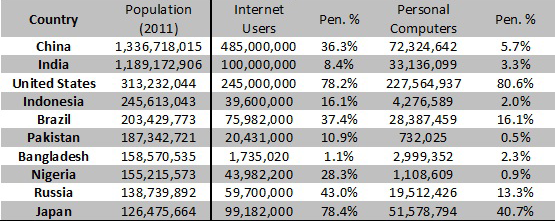CSR Fail: Why It’s Time for a BoP Tech Revolution
It’s true – we are in the age of PCs, broadband, Google, and, for better or worse, Facebook. (Fine, maybe it’s for the better, but it’s worth a healthy debate nonetheless.) All of us who wake up in the morning eager to scan our favorite blogs, news sites, and inboxes know this world all too well. Let’s be honest-it’s hard to imagine our lives without laptops and wireless coverage at our fingertips.
Some 2.1 billion people in the world are Internet users (inclusive of all types of connectivity-mobile, tablet, PC, etc.), 1.7 billion have personal computers, 517 million are registered users of Facebook, and 193 million people have Gmail accounts. But what about the rest? There are still billions who function, and thrive, without Internet access. In China, 850 million residents are non-Internet users and in India, non-users constitute over 1 billion of the country’s population see the Table 1 (split in two sections to fit).
Table 1: Top 10 Countries by Population and ICT Penetration


K-12 education systems everywhere – rural and urban, developed and underdeveloped, private and public – eagerly get students in front of computers as soon as possible. But at what cost? In the developing world, since most schools cannot bear the cost of a computer lab, they often rely on donations. However, many times these computers are barely functional corporate donations; plus, the process of getting used machines to schools in remote areas is arduous and time consuming. In my own experience on the receiving end of such CSR initiatives, only 24 of the 60 donated computers could be salvaged, and that was only possible thanks to the hard work of a computer engineer who described the donations as “scraps.” Our NGO had to assume all transportation, distribution, repair, and installation costs totaling 150+ hours of labor and the equivalent of two teachers’ monthly salaries.
Now that the machines are in schools, what next? The school must hire or train teachers who are computer literate – not an easy feat in rural India where less than one in 30 people have access to a PC. Donated machines do not come with educational programs or games to help tutor students on math, science, or history, either – it’s a blessing if they come with an operating system. And while the web has myriad of free, online resources for students and teachers both, Internet connectivity is not a reality for the majority of schools receiving these donations. (As an example, while I get up to 5 bars on my mobile phone at schools located in remote Indian villages, I cannot rely on Internet connectivity in the country’s IT capital of Bangalore. Come on, Indian telecom.)
I fully support technology in schools, but this must be directed with a purpose and be disruptive in nature. Getting PCs into schools without a plan to integrate them into the curriculum does more harm than good, often growing students’ fear of technology without the relevant tools or guidance. More focused solutions, on the other hand, can do a world of good. Worldreader, working in Ghana and Kenya, delivers e-readers to schools with the aim of improving literacy in underdeveloped areas. They manage the distribution process from source to school and even help the tools get integrated into the schools, working with stakeholders from the ministry of education to teachers, students, and parents. Today, Worldreader has managed to get 56,000 e-Books to Africa; in some schools, time spent reading has increased by 50 percent and in half an academic year, reading comprehension scores in some schools have increased by 13 percent.
Instead of pushing computers into schools-costly initiatives with a questionable ROI-let’s consider technology initiatives that are region- and market-appropriate. In India, while PC penetration is around 3 percent, mobile phone penetration is at a whopping 70 percent (see Table 2). The healthcare industry has capitalized on this and piloted several successful mobile health, or mHealth, solutions including mDhil, promoting health education through SMS, and other ventures supported by the United Nations, Vodafone, and Rockefeller Foundation collaboration, mHealth Alliance.

Similar initiatives for education, albeit on relatively smaller scales, have been launched in different parts of the world, including Text2Teach in the Philippines and BridgeIT in Tanzania, both bringing content for student and teachers directly to the classroom through mobile devices. (Other innovation solutions can be found through the UNESCO-sponsored Education Technology Debate.)
It’s up to all of us to change the tide and think about the intersection of technology inclusion and education more critically. It’s time for corporations to stop giving away their scrap computers to the developing world and calling it CSR. It’s time for NGOs to be more judicious about the hand-outs they accept with regards to the direct and indirect costs endured. Societies rely on technology to progress but it’s not necessary that all technologies are applicable and equally beneficial everywhere. Current mEducation initiatives have scratched the surface and it’s the responsibility of venture capitalists, angel investors, publishers, telecom providers, governments and the citizen sector to work together to propel mEducation to the next level.
Please like NextBillion on Facebook, follow us on Twitter and/or join our LinkedIn group.
- Categories
- Technology, Telecommunications
